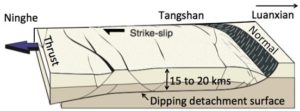22nd February 2022
Event phone:
Registration
PESGB members can register free of charge via the membership platform
If you are interested in becoming a member of PESGB please visit: https://www.ges-gb.org.uk/membership/
Event Information
Speaker: Dr Euan Mearns, ETH Zurich
Topic: The 1976 M7.8 Tangshan earthquake China
Abstract
The Great 1976 Tangshan Earthquake, China: a new transfer fault model and lessons for earthquake prediction
At 03:42 am on the 28 July 1976, the ground shook violently directly beneath the industrial and coal mining city of Tangshan, NE China, and minutes later, 650,000 people lay dead or seriously injured in rubble in what proved to be the most deadly earthquake on record. Just hours before, senior members of the fledgling State Seismological Bureau had met to evaluate the evidence that a large earthquake may soon occur in this part of the N China plain, but had decided to delay a decision for one more week that proved to be fateful.
Our research into this earthquake was focussed on the 1966-1976 earthquake prediction program, founded on the back of the 1966 Xingtai earthquake, and mentored by revered Premier Enlai Zhou. In order to get a more complete picture we also re-evaluated the structural geology and tectonics to gain understanding of the underlying mechanism of this deadly event.
Tangshan sits close to the northern margin of the N China Plain that is coincident with the northern edge of the Bohai Bay Rift Basin (BBB), which shares many structural features also seen in the North Sea. The traditional view was that the earthquake occurred on a dextral strike slip fault under a WSW-ENE compressional tectonic regime. We use the time-spatial distribution of the 20 largest shocks (M>5) of the whole sequence (that lasted for 16 months) to remap the faults into two linked transfer fault complexes. The faults thus mapped were then conditioned to fit the distribution of a larger set of M>4 aftershocks that persisted until December 1979 and the distribution of recently mapped surface soil gas anomalies. The dextral strike slip and normal faulting events of the main sequence (see below) are therefore mapped into the dominant transfer fault geometry of this part of the BBB.
Event 1, M 7.8, dextral strike slip, 03:42, 28 July 1976
Event 11, M7.1, normal fault, 18:45, 28 July 1976
We found that the faults as we map them are coincident with the distribution of telluric (electric) current anomalies and animal behaviour anomalies recorded at the time and that, with greater experience and data gathering capabilities, the earthquake could have been predicted and the population forewarned.
In the broader tectonic context, the BBB formed during an active rifting phase that began in the Palaeocene and persisted until the Oligocene. This then gave way to thermal subsidence. Localised high heat flow, deep gravity anomalies and the widespread occurrence of hot springs may suggest that during the Quaternary a new active rifting phase began that could explain the widespread occurrence of large earthquakes across the BBB and adjoining Shaanxi Rifts.

The proposed transfer fault geometry for the Tangshan sequence of events, that lasted for 16 months, showing the notional locations of the three main events (M>7) Tangshan, Luanxian and Ninghe. The graphic shows only one of two linked transfer fault complexes required to accommodate the whole event sequence. Adapted with consent from Figure 18.3a of Fossen, H., 2010. Structural Geology. Cambridge University Press.
Venue Information
Venue information
Venue name:
Virtual Event

